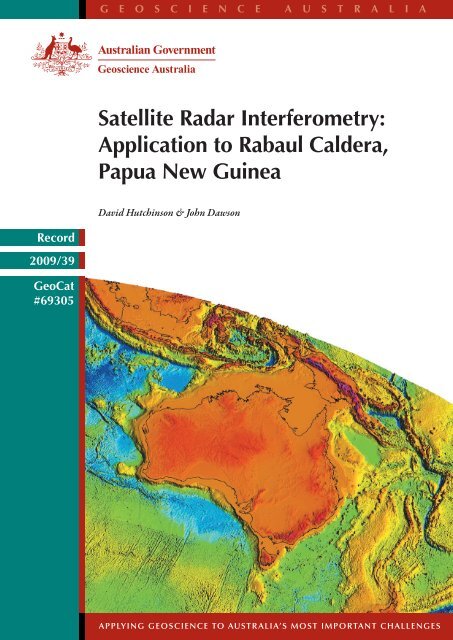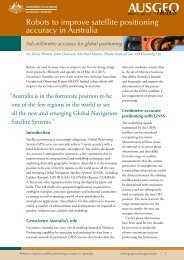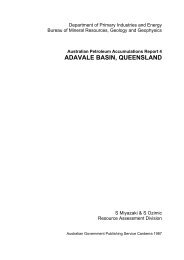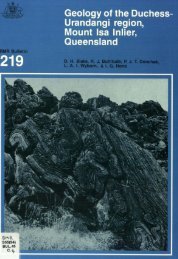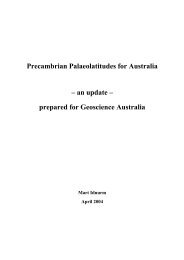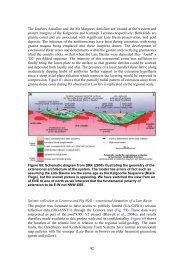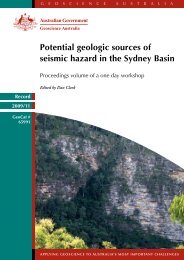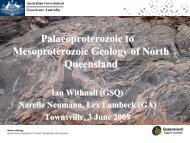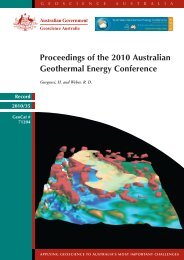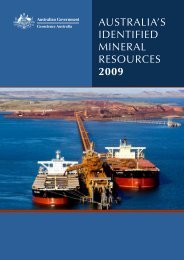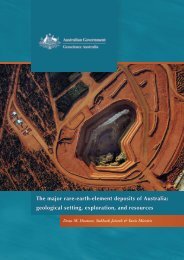Satellite Radar Interferometry - Geoscience Australia
Satellite Radar Interferometry - Geoscience Australia
Satellite Radar Interferometry - Geoscience Australia
You also want an ePaper? Increase the reach of your titles
YUMPU automatically turns print PDFs into web optimized ePapers that Google loves.
G E O S C I E N C E A U S T R A L I A<br />
<strong>Satellite</strong> <strong>Radar</strong> <strong>Interferometry</strong>:<br />
Application to Rabaul Caldera,<br />
Papua New Guinea<br />
David Hutchinson & John Dawson<br />
Record<br />
2009/39<br />
GeoCat<br />
#69305<br />
APPLYING GEOSCIENCE TO AUSTRALIA’S MOST IMPORTANT CHALLENGES
<strong>Satellite</strong> <strong>Radar</strong> <strong>Interferometry</strong>: Application<br />
to Rabaul Caldera, Papua New Guinea<br />
GEOSCIENCE AUSTRALIA<br />
RECORD 2009/39<br />
by<br />
David K. Hutchinson 1 and John H. Dawson 1<br />
1. <strong>Geoscience</strong> <strong>Australia</strong>
Department of Resources, Energy and Tourism<br />
Minister for Resources and Energy: The Hon. Martin Ferguson, AM MP<br />
Secretary: Mr John Pierce<br />
<strong>Geoscience</strong> <strong>Australia</strong><br />
Chief Executive Officer: Dr Neil Williams PSM<br />
© Commonwealth of <strong>Australia</strong>, 2009<br />
This work is copyright. Apart from any fair dealings for the purpose of study, research, criticism,<br />
or review, as permitted under the Copyright Act 1968, no part may be reproduced by any process<br />
without written permission. Copyright is the responsibility of the Chief Executive Officer,<br />
<strong>Geoscience</strong> <strong>Australia</strong>. Requests and enquiries should be directed to the Chief Executive Officer,<br />
<strong>Geoscience</strong> <strong>Australia</strong>, GPO Box 378 Canberra ACT 2601.<br />
<strong>Geoscience</strong> <strong>Australia</strong> has tried to make the information in this product as accurate as possible.<br />
However, it does not guarantee that the information is totally accurate or complete. Therefore, you<br />
should not solely rely on this information when making a commercial decision.<br />
ISSN 1448-2177<br />
ISBN 978-1-921672-36-1<br />
GeoCat # 69305<br />
Bibliographic reference: Hutchinson, D.K. and Dawson, J.H., 2009, <strong>Satellite</strong> <strong>Radar</strong> <strong>Interferometry</strong>:<br />
Application to Rabaul Caldera, <strong>Geoscience</strong> <strong>Australia</strong> Record 2009/39, 19pp.
<strong>Satellite</strong> <strong>Radar</strong> <strong>Interferometry</strong>: Application to Rabaul Caldera<br />
Contents<br />
Executive Summary..............................................................................................................................1<br />
Introduction...........................................................................................................................................2<br />
Rabaul ...............................................................................................................................................2<br />
Rabaul Caldera..............................................................................................................................2<br />
Rabaul Volcanological Observatory (RVO) .................................................................................2<br />
Volcano hazard Monitoring ..............................................................................................................2<br />
Remote Sensing Techniques .........................................................................................................3<br />
Geodetic Techniques.....................................................................................................................3<br />
InSAR ...............................................................................................................................................3<br />
SAR Images ..................................................................................................................................3<br />
Topography...................................................................................................................................4<br />
<strong>Interferometry</strong> ...............................................................................................................................4<br />
Phase Unwrapping ........................................................................................................................5<br />
Limitations of InSAR....................................................................................................................6<br />
Data.......................................................................................................................................................6<br />
ALOS PALSAR Acquisitions...........................................................................................................6<br />
Interferogram Processing..................................................................................................................7<br />
Interferogram Stacking .....................................................................................................................8<br />
Results...................................................................................................................................................9<br />
Single Interferograms........................................................................................................................9<br />
Time Series of Deformations ..........................................................................................................10<br />
Discussion...........................................................................................................................................13<br />
Conclusion ..........................................................................................................................................14<br />
Acknowledgements.........................................................................................................................14<br />
References.......................................................................................................................................14<br />
iii
<strong>Satellite</strong> <strong>Radar</strong> <strong>Interferometry</strong>: Application to Rabaul Caldera<br />
Executive Summary<br />
Interferometric synthetic aperture radar (InSAR) is a geodetic monitoring tool used to measure<br />
ground deformations at centimetre-scale precision. InSAR has been used to study many geophysical<br />
phenomena, including volcanoes and earthquakes. This technique has yet to be applied widely in<br />
Papua New Guinea, despite its potential as a hazard monitoring tool for the numerous volcanoes in<br />
the region. This study applies InSAR to the Rabaul caldera, to investigate the feasibility of the<br />
technique in the region. This location was chosen so that the results of this study can be compared to<br />
ground based measurements provided by the Rabaul Volcano Observatory.<br />
Of the 10 radar images acquired for this study, 7 were successfully processed to form<br />
interferograms. These interferograms were then stacked together to form a time series of<br />
deformations, spanning a 14 month period from 27 February 2007 to 16 April 2008. Most of these<br />
interferograms had high coherence, and relatively low noise, with centimetre-scale deformations<br />
evident in the deformation time series. These results suggest that this technique is capable of<br />
detecting surface deformation associated with volcanic eruptions. The primary limitations to the<br />
analysis were the availability of radar data, and the baseline separation between acquisitions. We<br />
were unable to apply temporal filtering to remove atmospheric noise, since there were too few<br />
acquisitions in the time series.<br />
1
<strong>Satellite</strong> <strong>Radar</strong> <strong>Interferometry</strong>: Application to Rabaul Caldera<br />
Introduction<br />
RABAUL<br />
Rabaul caldera has had numerous periods of activity during the 20th century. Its activity poses a<br />
major danger to local residents, as well as the infrastructure of Rabaul town. The most notable<br />
eruption in terms of human cost was the eruption of 1937, which killed 500 people. The last major<br />
eruption occurred in 1994, which destroyed much of Rabaul town and its infrastructure. It continues<br />
to pose a significant danger to the town and its residents. The ash clouds produced by the volcano<br />
are also hazardous for aircraft.<br />
Rabaul Caldera<br />
Rabaul caldera is one of many calderas on the Gazelle Peninsula in the northeast of New Britain.<br />
Rabaul caldera contains two active volcanoes, Vulcan and Tavurvur, as well as several other<br />
dormant ones. There is a significant magma reservoir located at 3-6 km depth beneath the caldera, as<br />
revealed by seismic tomographic imaging (Finlayson et al., 2003). The Rabaul caldera presents an<br />
ideal location for testing the InSAR technique in Papua New Guinea (PNG), because it contains<br />
active volcanoes, and there are a number of ground based geodetic monitoring stations in the area.<br />
The ground based geodetic systems can be used to validate the results found in this study, and to<br />
assess the accuracy of InSAR in this region. InSAR may also be able to reveal activity in the region<br />
that has not been observed previously, which can assist in choosing where to deploy ground based<br />
monitoring systems.<br />
Rabaul Volcanological Observatory (RVO)<br />
<strong>Geoscience</strong> <strong>Australia</strong> (GA) and its predecessors have been involved in monitoring the Rabaul<br />
volcanic complex since the 1940s. GA has a long term partnership with the Rabaul Volcanological<br />
Observatory (RVO), which is responsible for monitoring volcanoes throughout PNG. GA provides<br />
scientific and technical assistance to the RVO, through a hazard monitoring programme funded by<br />
the <strong>Australia</strong>n Agency for International Development (AusAID). A detailed account of the<br />
partnership between GA and the RVO can be found elsewhere (AusAID, 1996; Fisher, 2005).<br />
One of the aims in the partnership between GA and the RVO is to help the RVO become more selfsufficient<br />
in their capacity to monitor volcano hazards. However, due to limited resources, it remains<br />
advantageous for the RVO to collaborate with agencies in developed countries. Agencies such as<br />
GA have the capacity to purchase and process remote sensing data, in situations where the RVO<br />
lacks the technology or funding to perform their own analysis. Partnerships like this are likely to<br />
remain important to the RVO, especially as remote sensing techniques become more advanced and<br />
widespread.<br />
VOLCANO HAZARD MONITORING<br />
Predicting volcanic eruptions is a challenging process, since it usually requires a suite of different<br />
monitoring techniques. These techniques consist of both ground based measurements and remote<br />
sensing techniques. Ground based measurements consist primarily of seismic monitoring, ground<br />
deformation measurements using GPS and tiltmeters, and monitoring of gaseous emissions such as<br />
sulphur dioxide. Seismometers and GPS devices provide useful real-time volcano monitoring.<br />
However they are expensive to set up and maintain, and therefore are usually available only in a few<br />
2
<strong>Satellite</strong> <strong>Radar</strong> <strong>Interferometry</strong>: Application to Rabaul Caldera<br />
selected locations. Thus ground based detection methods can provide only a limited spatial array of<br />
information.<br />
Remote Sensing Techniques<br />
Volcanic activity can also be detected using a number of different remote sensing techniques. Some<br />
important geophysical features which can be observed using remote sensing are ground<br />
deformations, sulphur dioxide emissions, and gravity, magnetic and thermal anomalies. The main<br />
advantages of remote sensing are the high spatial density of data, and relatively low cost. On the<br />
other hand, these techniques are usually hindered by low temporal resolution, and often there are<br />
time delays between the acquisition and processing of data. These techniques can also require<br />
complex data processing, which can further delay the process. Therefore remote sensing techniques<br />
are often incapable of providing early warnings for volcano eruptions, and can only be utilised for<br />
post eruption analysis.<br />
Geodetic Techniques<br />
There are a number of geodetic techniques that can provide useful information for monitoring<br />
volcanoes. These methods consist of both on-site surveying techniques, such as GPS, levelling and<br />
tiltmeters, and remote sensing techniques, such as satellite radar interferometry. These techniques<br />
are all used to measure deformations in the earth's surface, and from these deformations one can<br />
deduce changes in the magma body beneath the caldera. This report focuses on the use satellite radar<br />
interferometry, which is outlined in the following section.<br />
INSAR<br />
Interferometric synthetic aperture radar (InSAR) is a remote sensing technique for measuring<br />
changes in topography over time. The technique originated from the field of radio astronomy, before<br />
being adapted to Earth-based measurements (Goldstein et al., 1988; Gabriel et al. 1989). InSAR can<br />
be used to detect centimetre-scale vertical deformations at a horizontal resolution of tens of meters.<br />
The technique has become a common geodetic tool, used routinely to measure surface deformation<br />
associated with earthquakes and volcanic eruptions. There are extensive reviews of the InSAR<br />
technique available in the literature (Massonnet and Feigl, 1998; Rosen et al. 2000; Zebker, 2000;<br />
Dzurisin, 2003; Richards, 2007). We give a brief outline of the steps involved in InSAR, followed by<br />
a discussion of its potential and limitations.<br />
SAR Images<br />
Synthetic aperture radar (SAR) is an imaging technique that uses a moving radar sensor to capture<br />
signals over a large area. SAR systems are generally mounted on aircraft or satellites. A SAR system<br />
emits a radar beam to the ground, with a known phase and frequency and constructs an image from<br />
the reflected beam using three measurements (Harger, 1970). These measurements are:<br />
<br />
<br />
<br />
Phase - corresponding to a time delay associated with the distance between the radar and the<br />
ground point<br />
Doppler shift - measuring the relative velocity between the radar system and the ground point<br />
Intensity - the reflectivity of the ground at each point.<br />
3
<strong>Satellite</strong> <strong>Radar</strong> <strong>Interferometry</strong>: Application to Rabaul Caldera<br />
Assuming the ground area of interest is flat, the phase and the Doppler signals can be used to<br />
uniquely determine the location of the signal in 2D space. Thus an image of intensity can be formed<br />
using the 2D coordinate system from the phase and Doppler signals (Harger, 1970).<br />
While SAR can be used as a conventional imaging system, a more exciting application for geodesy<br />
is interferometric synthetic aperture radar (InSAR) where 2 or more SAR signals are combined to<br />
measure deformation of the surface. SAR systems operate by emitting and receiving a coherent,<br />
monochromatic radio beam. The radio beam is emitted at microwave frequencies, in one of the X, C,<br />
S, L or P bands (Elachi, 1988; Bamler and Hartl, 1998). The frequency and wavelength intervals of<br />
each of these bands are listed in Table 1 (Dawson, 2008).<br />
Table 1: Frequencies and wavelengths of the microwave bands used in SAR acquisitions (Dawson,<br />
2008).<br />
BAND FREQUENCY (GHZ) WAVELENGTH (CM)<br />
P < 0.3 100<br />
L 1-2 15-30<br />
S 2-4 7.5-15<br />
C 4-8 3.75-7.5<br />
X 8-12 2.5-3.75<br />
Topography<br />
Since SAR images are formed in two dimensions only, the impact of topography must be taken into<br />
account when analysing the signal. Regions of elevated topography shorten the range between the<br />
satellite and the ground, which alters the phase signal. Therefore SAR images must be corrected for<br />
topography. This can be done using a reference digital elevation model (DEM), or by deducing a<br />
topographic phase signal from two SAR images (eg: Rosen et al. 2000). In order to measure<br />
topography from two different SAR images, the satellite tracks must measure the image from<br />
slightly different trajectories. The two signals differ slightly due to parallax, and these parallax<br />
differences can be inverted to solve for height at each point.<br />
<strong>Interferometry</strong><br />
Once two SAR images have been acquired, the phase differences between the two images are used<br />
to measure line of sight deformations of the topography. The map of the phase differences is called<br />
an interferogram, where large deformation signals are represented by a series of periodic fringes in<br />
the phase. The process of forming an interferogram requires that the two phase maps are ‘coherent’,<br />
which means that the surface response between the two acquisitions remains similar. Coherence also<br />
requires that the two SAR images have been acquired from very similar look positions, otherwise<br />
parallax changes the apparent shape of the topography.<br />
Figure 1 shows a schematic diagram of the geometry of InSAR. A 1 and A 2 represent the satellite<br />
positions, and ρ 1 and ρ 2 are the corresponding values of range from the satellite to the ground area<br />
being imaged. The unit vector in the direction from the satellite to the ground is known as the ‘look<br />
vector’. B is the ‘baseline’ vector, and represents the separation between the two satellite positions.<br />
B ┴ is the ‘perpendicular baseline’, and represents the satellite separation in the direction<br />
perpendicular to the look vector.<br />
4
<strong>Satellite</strong> <strong>Radar</strong> <strong>Interferometry</strong>: Application to Rabaul Caldera<br />
Figure 1: Schematic diagram of the geometry of InSAR, discussed in the text. Figure adapted<br />
from Bürgmann et al. (2000).<br />
When the two SAR images are compared, a change in range δρ between the images is deduced from<br />
the phase change δφ between the radar signals, using<br />
δρ = - λ / 4π * δφ,<br />
where λ is the radar instrument wavelength. δρ can then be interpreted as a deformation of<br />
topography, in the line of sight of the satellite.<br />
Phase Unwrapping<br />
Phase is a periodic quantity, and cycles over the interval (-π,π]. Phase values larger than π, or smaller<br />
than –π are simply ‘wrapped’ back into the interval, by adding or subtracting a multiple of 2π. For<br />
example, a phase value of 3π is equivalent to π. The periodicity of the phase means that the range is<br />
initially ambiguous, as multiple values of range correspond to the same phase measurement.<br />
In order to reconstruct the actual range map, the ambiguity of the phase must be removed through a<br />
process called ‘unwrapping’. Phase unwrapping assumes that the phase changes (from the real<br />
signal) between neighbouring pixels are small compared to the 2π interval in which the signal is<br />
wrapped. If this assumption holds, then large phase differences (comparable to 2π) between pixels<br />
can be identified as periodic phase jumps and corrected by adding or subtracting 2π. A further<br />
requirement of the unwrapping process is that the sampling interval must be below a critical<br />
threshold, so that neighbouring pixels are close enough to each other to ensure that the phase map is<br />
smooth. In regions of steep topography, for example around cliffs, the unwrapping process breaks<br />
down, since it cannot distinguish between unwrapping errors and naturally large phase changes.<br />
5
<strong>Satellite</strong> <strong>Radar</strong> <strong>Interferometry</strong>: Application to Rabaul Caldera<br />
Limitations of InSAR<br />
Different factors can hinder the acquisition and processing of InSAR data. One of the main<br />
difficulties is that the surface backscatter response must remain consistent between SAR<br />
acquisitions. This consistency is needed, because the phase signal must be coherent to form an<br />
interferogram between SAR images. If the land is reshaped by processes such as erosion or heavy<br />
precipitation, it can become impossible to form a coherent interferogram. <strong>Radar</strong> phase measurements<br />
can also be altered by atmospheric features, such as water vapour or interference from the<br />
ionosphere. This atmospheric noise means that the InSAR technique is generally more reliable if a<br />
large number of SAR acquisitions are available. When a long time series is available, the<br />
atmospheric signal can be reduced using temporal filtering (Berardino et al., 2002).<br />
These issues can limit the capacity of InSAR to be used as an early warning system for volcano<br />
eruptions. Sometimes the deformation signal from a recent SAR acquisition cannot be reliably<br />
analysed until several later acquisitions have been taken. Since repeat pass times are of the order of 1<br />
month, the time delay between the actual deformation event and the completion of data processing<br />
may be several months. It is for this reason that most InSAR studies of volcanoes have been<br />
conducted after the event, as opposed to using InSAR as a real-time monitoring system.<br />
The choice of radar wavelength also places limitations on the operational capacity of InSAR. Shorter<br />
wavelengths, such as C-band and X-band, can provide higher precision measurements. However,<br />
these shorter wavelengths cannot penetrate vegetation. On the other hand, L-band radar can<br />
generally penetrate vegetation, so it is generally reflected by the ground itself. Thus in order to<br />
achieve global InSAR coverage from a single satellite mission, L-band wavelengths are the most<br />
reliable, even though they do not provide the highest precision (Stevens and Wadge, 2004).<br />
The use of SAR imagery in creating topographic maps creates a minor conflict of interest for InSAR<br />
data acquisition. When measuring topography using InSAR, it is advantageous to have a larger<br />
baseline between data acquisitions. This is because a larger baseline creates a greater parallax signal,<br />
which increases the precision of topography measurements. On the other hand, forming an<br />
interferogram between SAR images requires a small baseline between acquisitions to achieve<br />
coherence between the two phase maps (Rosen et al., 2000). Therefore a SAR mission cannot be<br />
optimised for both topographic mapping and measurement of deformation. Since there are a limited<br />
number of satellites that acquire SAR data, these conflicting needs can reduce the data available for<br />
InSAR.<br />
Data<br />
ALOS PALSAR ACQUISITIONS<br />
The SAR images used in this study were acquired by the ALOS PALSAR satellite, operated by the<br />
Japan Aerospace Exploration Agency (JAXA). A total of 10 images, between the dates of 12<br />
January 2007 and 17 January 2009 were obtained from JAXA. On the JAXA online catalogue, these<br />
images can be located using its observation number: 352, and its scene ID: 7090. The image<br />
acquisition dates are shown in Table 2. Seven of the ten images formed a small baseline subset, and<br />
were used to form a series of interferograms. Unfortunately, 3 of the images had large orbital<br />
separations from the small baseline subset, which made them unsuitable for forming interferograms.<br />
This limited the time series to between the dates of 27 February 2007 and 16 April 2008, as<br />
indicated in Table 2.<br />
6
<strong>Satellite</strong> <strong>Radar</strong> <strong>Interferometry</strong>: Application to Rabaul Caldera<br />
Table 2: Dates of SAR images acquired for this study. Images 2-8 all had relatively short baselines<br />
with respect to each other. This subset of images 2 to 8 will be referred to as the small baseline<br />
subset, since the baseline values were of the order of 200 m. Images 1, 9 and 10 had much larger<br />
separations (approximately 1000 m) from the small baseline subset, which made it impossible to<br />
form interferograms with these images.<br />
IMAGE #<br />
IMAGE DATE<br />
SUITABLE FOR<br />
INTERFEROGRAMS<br />
1 12 January 2007 no<br />
2 27 February 2007 yes<br />
3 15 July 2007 yes<br />
4 30 August 2007 yes<br />
5 15 October 2007 yes<br />
6 15 January 2008 yes<br />
7 01 March 2008 yes<br />
8 16 April 2008 yes<br />
9 17 October 2008 no<br />
10 17 January 2009 no<br />
INTERFEROGRAM PROCESSING<br />
The 7 SAR images from the small baseline subset were processed to create a series of 19<br />
interferogram pairs. These interferogram pairs are listed in Table 3, showing the dates of the images,<br />
and their perpendicular baselines. As discussed in the introduction, interferograms can only be<br />
formed if the baseline is relatively small. Each interferogram pair consists of a ‘master’ and a ‘slave’<br />
image, where the master image is assigned to the later date by convention. Thus the master image<br />
can be interpreted as a deformation with respect to the slave image.<br />
The interferograms were processed using the Repeat Orbit <strong>Interferometry</strong> Package (ROI-PAC). ROI-<br />
PAC is an open source software package, provided by the Jet Propulsion Laboratory of the National<br />
Aeronautics and Space Administration (NASA).<br />
7
<strong>Satellite</strong> <strong>Radar</strong> <strong>Interferometry</strong>: Application to Rabaul Caldera<br />
Table 3: List of the 19 interferogram pairs formed for this study, showing the dates of the SAR<br />
images, the perpendicular baseline, and the time between images. The interferogram pairs are<br />
grouped below according to the 6 different master image dates.<br />
INTERFEROGRAM<br />
#<br />
MASTER IMAGE<br />
DATE<br />
SLAVE IMAGE<br />
DATE<br />
PERPENDICULAR<br />
BASELINE (M)<br />
ΔT (DAYS)<br />
1 15 July 2007 27 February 2007 32 138<br />
2 30 August 2007 27 February 2007 143 184<br />
3 30 August 2007 15 July 2007 111 46<br />
4 15 October 2007 27 February 2007 171 230<br />
5 15 October 2007 15 July 2007 139 92<br />
6 15 October 2007 30 August 2007 28 46<br />
7 15 January 2008 15 July 2007 129 184<br />
8 15 January 2008 30 August 2007 228 138<br />
9 15 January 2008 15 October 2007 248 92<br />
10 01 March 2008 27 February 2007 215 368<br />
11 01 March 2008 15 July 2007 230 230<br />
12 01 March 2008 30 August 2007 329 184<br />
13 01 March 2008 15 October 2007 349 138<br />
14 01 March 2008 15 January 2008 101 46<br />
15 16 April 2008 15 July 2007 237 276<br />
16 16 April 2008 30 August 2007 336 230<br />
17 16 April 2008 15 October 2007 356 184<br />
18 16 April 2008 15 January 2008 108 92<br />
19 16 April 2008 01 March 2008 7 47<br />
A major challenge in the processing of interferograms is to obtain coherence between the phase<br />
maps of different SAR images. To achieve coherence between SAR images, it usually necessary to<br />
apply spatial averaging to reduce noise. The standard spatial averaging method used in InSAR is<br />
‘multilooking’. This consists of grouping neighbouring pixels into blocks, and generating a new<br />
pixel from the average value of the block. As well as reducing noise, this technique allows the image<br />
to be resampled into square pixels (as the raw data consists of rectangular pixels). The drawback of<br />
multilooking is that it reduces the resolution of the interferogram. Therefore it is advantageous to set<br />
the multilook interval to the lowest possible value that will produce a coherent interferogram. In this<br />
study, each pixel was multilooked using 8 pixels in the range direction. (We also attempted to use a<br />
multilook interval of 4 range pixels, however this caused many of the interferograms to become<br />
incoherent.) The azimuth multilooking ratio was adjusted relative to achieve the same pixel length as<br />
the range direction.<br />
INTERFEROGRAM STACKING<br />
The interferograms described above measure the deformation between pairs of SAR images only.<br />
The next stage of the analysis was to stack the interferograms together, to form a time series of<br />
deformations over the entire period of data acquisitions. Since all of the interferograms used in this<br />
study come from the same small baseline subset, the stacking process consisted of a simple least<br />
squares solution. If the interferograms did not form a single baseline subset, the stacking process<br />
would be more complex. A full description of the stacking algorithm used to create this least squares<br />
solution is given by Berardino et al. (2002).<br />
8
<strong>Satellite</strong> <strong>Radar</strong> <strong>Interferometry</strong>: Application to Rabaul Caldera<br />
Results<br />
SINGLE INTERFEROGRAMS<br />
The SAR images used in this study cover a large area in the north-east of New Britain. Figure 2<br />
shows a sample interferogram, which shows the full extent of the SAR images (in colour), with<br />
topography overlaid on the image. The area of interest around Rabaul is much smaller than this<br />
image, so for the remainder of the analysis, we restrict our field of view to the Rabaul area only.<br />
Figure 2: A sample interferogram, showing the full extent of the image swath, as well as the<br />
topography in the north-eastern region of New Britain.<br />
9
<strong>Satellite</strong> <strong>Radar</strong> <strong>Interferometry</strong>: Application to Rabaul Caldera<br />
The 19 pairs of interferograms formed in this study were subject to differing levels of coherence. In<br />
most cases, a shorter baseline and temporal separation lead to greater coherence. An example of this<br />
is shown by comparing Figure 3a with 3b, showing interferograms of high and low coherence<br />
respectively. The baseline and temporal separations in Figure 3a are much smaller than those in<br />
Figure 3b.<br />
Figure 3: A sample showing the differing coherence levels in the interferograms created. (a)<br />
shows a highly coherent interferogram, with a short baseline and temporal separation. (b) shows<br />
an interferogram with lower coherence, with a longer baseline and temporal separation. The<br />
grey areas in (b) represent pixels that have fallen below a coherence threshold of 0.1.<br />
TIME SERIES OF DEFORMATIONS<br />
The interferograms were stacked together to form a time series of deformations, using the algorithm<br />
of Berardino et al. (2002). Some pixels fell below the coherence threshold, like those shown in<br />
Figure 3b, and so were assigned no value in the single interferogram processing. In order to run the<br />
stacking algorithm, these missing pixels were assigned values using nearest-neighbour interpolation.<br />
The steps in the time series corresponded to the 7 dates of the SAR images. The first date (27-02-<br />
2007) in the series was assigned a deformation value of zero, and the subsequent 6 dates were<br />
measured as deformations with respect to the first date. These deformations are shown in the series<br />
of images in Figure 4. The series shows little change in the first two images (Figures 4a-b), apart<br />
from a small area of subsidence to the south-west of Tavurvur.<br />
Figures 4c-f show broad subsidence around the Kombiu volcano, to the north-east of Tavurvur.<br />
These time steps also show the beginning of subsidence around Vulcan. Both of these signals are<br />
evident in 4 successive images. It is therefore likely that these two areas of subsidence are real<br />
signals, as an atmospheric artefact is unlikely to persist through multiple time steps. However, the<br />
amplitude (~ 5 cm) and spatial extent of the subsidence around Vulcan is significantly larger in the<br />
final time step (Figure 4f) than in the previous ones. It would therefore be desirable to extend the<br />
10
<strong>Satellite</strong> <strong>Radar</strong> <strong>Interferometry</strong>: Application to Rabaul Caldera<br />
time series past this final step, to exclude the possibility that the Vulcan subsidence is due to<br />
atmospheric noise. It would also be useful to corroborate this signal against ground-based GPS<br />
measurements.<br />
Figure 4e shows large amplitude signals (~ 8 cm) of subsidence that are not present in either the<br />
previous or next time steps. It is possible that this signal of subsidence may be partly due to<br />
atmospheric noise. If the signal is real, it implies a trend of broad subsidence over a 46 day period,<br />
followed by an opposite trend of uplift of similar magnitude over the following 47 day period. While<br />
it is possible for deformations such as these to occur over short timescales, the immediate reversal of<br />
the subsidence suggests that atmospheric noise may be a factor. Without further data to corroborate<br />
this signal, it is difficult to distinguish between the possible atmospheric and geodetic contributions.<br />
The subsidence in the Kombiu region is a very consistent trend in the time series. In addition to the<br />
longer term trend, the strong subsidence apparent in Figure 4e also occurs close to this region,<br />
though in this time step atmospheric noise may be a factor (as discussed above). This Kombiu<br />
subsidence coincides with a low-velocity anomaly found using seismic tomography (Bai and<br />
Greenhalgh, 2005). This low-velocity anomaly may be evidence of a magma chamber, making the<br />
Kombiu area one of volcanological interest. Although the time series in this study is somewhat<br />
sparse, the subsidence found suggests that further geodetic monitoring of Kombiu may be of interest.<br />
11
<strong>Satellite</strong> <strong>Radar</strong> <strong>Interferometry</strong>: Application to Rabaul Caldera<br />
Figure 4: Deformations shown at each time step, using the stacking method of Berardino et al.<br />
(2002). The deformations are measured with respect to the first SAR image, taken on 27-02-<br />
2007.<br />
The RVO has three GPS stations in the area, which in principle can be used to ground-truth the<br />
deformation signals found in this InSAR study. However, only one of the GPS stations was<br />
12
<strong>Satellite</strong> <strong>Radar</strong> <strong>Interferometry</strong>: Application to Rabaul Caldera<br />
operational during the time period of this study. This station was located on Matupit Island. Figure 5<br />
shows a time series of deformations, comparing the GPS data from the RVO (RVO, 2009) with the<br />
InSAR deformation signal from the same location. The deformation signal shows a reasonable<br />
agreement for most of the time series, although the GPS data shows a trend of subsidence (up to 6<br />
cm) at the end of the time series that is not matched by the InSAR data (roughly 2-3 cm). It would be<br />
therefore of interest to extend the InSAR time series (if the data were available), to see if this trend<br />
of subsidence is seen in further time steps.<br />
It should also be noted that Matupit Island is not an ideal location for interferogram processing, since<br />
it is a very small area of land surrounded by water. Small islands like this are prone to unwrapping<br />
errors. The unwrapping process is usually more reliable when performed over large, contiguous<br />
areas of land.<br />
Figure 5: Time series of deformations at Matupit Island, comparing the GPS data from the RVO,<br />
with our InSAR results from the same location.<br />
Discussion<br />
This study has demonstrated the potential of InSAR to be used as a monitoring tool for volcanoes in<br />
PNG. The ALOS L-band radar acquisitions have been successfully processed to form a time series<br />
of deformations, spanning a 14 month period. Seven of the 10 SAR images purchased for this area<br />
formed a short baseline subset, suitable for interferogram processing. The primary limitation to the<br />
time series was the availability of data. Only 10 images were available over this area within a period<br />
of 2 years. This forced us to form interferograms with large temporal separations (some larger than 6<br />
months). A greater frequency of SAR images would also allow us to apply temporal filtering, to<br />
remove atmospheric errors.<br />
13
<strong>Satellite</strong> <strong>Radar</strong> <strong>Interferometry</strong>: Application to Rabaul Caldera<br />
Rabaul was chosen as the location of this pilot study because there are independent data available to<br />
validate the results. It is now possible to compare the deformation signals found here with ground<br />
based measurements of deformations collected by the RVO. Drawing comparisons with the ground<br />
based data will be an important step in assessing the accuracy of InSAR in PNG. In the long term,<br />
InSAR promises to be especially useful in areas where ground based measurements are not<br />
available. Using the global coverage of SAR satellites, InSAR can be used to monitor any of the<br />
numerous volcanoes in PNG, and the region.<br />
In terms of providing volcano warnings, ground based measurements will always be necessary, since<br />
they are needed to record geophysical change in real time. However, these ground based instruments<br />
cannot be installed everywhere, since they are costly and require on-site maintenance. Therefore<br />
ground based monitoring systems are generally placed only in locations where volcanoes are known<br />
to be hazardous. InSAR could be used to identify volcanoes that are becoming active. This<br />
information could then be used to select locations where better real time monitoring systems are<br />
needed.<br />
Conclusion<br />
ALOS SAR images were processed to form an array of interferograms. These interferograms were<br />
stacked together to form a time series of deformations, spanning a 14 month period from 27-2-2007<br />
to 16-4-2008. A broad region of subsidence was found around Vulcan and Kombiu, although the<br />
amplitude of deformation was only about 6 cm in both cases. The centimetre-scale precision, and<br />
relatively low noise in the interferograms suggest that this technique could feasibly detect uplift or<br />
subsidence as precursors to an eruption. InSAR therefore has the potential to identify volcano<br />
hazards, which will be especially useful in the absence of ground based monitoring systems.<br />
ACKNOWLEDGEMENTS<br />
We would like to thank Steve Saunders and Ima Itikarai from the RVO, for providing us with useful<br />
information from their ground based observations, including GPS and tiltmeter data. We would also<br />
like to thank Shane Nancarrow and Wally Johnson for their advice and feedback during the project.<br />
REFERENCES<br />
AusAID, 1996. Papua New Guinea – <strong>Australia</strong> Volcanological Service Support Project Phase 2.<br />
Project Design Document: <strong>Australia</strong>n Agency for International Development.<br />
Bamler, R. and Hartl, P., 1998. Synthetic aperture radar interferometry. Inverse Problems, 14(4): 1.<br />
Berardino, P., Fornaro, G., Lanari, R., and Sansosti, E., 2002. A new algorithm for surface<br />
deformation monitoring based on small baseline differential SAR interferograms. IEEE<br />
Trans. Geosci. Remote Sens.,, 40(11): 2375-2383.<br />
Bürgmann, R., Rosen, P. and Fielding, E., 2000. Synthetic aperture radar interferometry to measure<br />
Earth’s surface topography and its deformation. Ann. Rev. Earth Planet Sci. 28: 169-209.<br />
Dawson, J., 2008. <strong>Satellite</strong> <strong>Radar</strong> <strong>Interferometry</strong> with Application to the Observation of Surface<br />
Deformation in <strong>Australia</strong>. Ph.D. thesis, The <strong>Australia</strong>n National University.<br />
Dzurisin, D., 2003. A comprehensive approach to monitoring volcano deformation as a window on<br />
the eruption cycle. Rev. Geophys., 41(1): 1001.<br />
Elachi, C., 1988. Spaceborne radar remote sensing.IEEE-Press.<br />
Fisher, A., 2005. Volcano Monitoring in the Asia-Pacific Region with <strong>Satellite</strong> Imagery. Internal<br />
report, <strong>Geoscience</strong> <strong>Australia</strong>.<br />
14
<strong>Satellite</strong> <strong>Radar</strong> <strong>Interferometry</strong>: Application to Rabaul Caldera<br />
Finlayson, D., Gudmundsson, O., Itikarai, I., Nishimura, Y., and Shimamura, H., 2003. Rabaul<br />
volcano, Papua New Guinea: seismic tomographic imaging of an active caldera. Journal of<br />
Volcanology and Geothermal Research, 124: 153-171.<br />
Gabriel, A., Goldstein, R., and Zebker, H., 1989. Mapping small elevation changes over large areas:<br />
Differential radar interferometry. J. Geophys. Res., 94(B7): 9183-9191.<br />
Goldstein, R., Zebker, H., and Werner, C., 1988. <strong>Satellite</strong> radar interferometry: two-dimensional<br />
phase unwrapping. Radio Sci., 23(4): 713-720.<br />
Harger, R., 1970. Synthetic Aperture <strong>Radar</strong> Systems: Theory and Design. Academic Press.<br />
Massonnet, D. and Feigl, K., 1998. <strong>Radar</strong> interferometry and its application to changes in the earth’s<br />
surface. Rev. Geophys., 36(4): 441-500.<br />
Richards, M., 2007. A beginner’s guide to interferometric SAR concepts and signal processing.<br />
IEEE Aerospace and Electronic Systems Magazine, 22(9): 5.<br />
Rosen, P., Hensley, S., Joughin, I., Li, F., Madsen, S., Rodriguez, E., and Goldstein, R., 2000.<br />
Synthetic aperture radar interferometry. Proc. IEEE, 88(3): 333-382.<br />
RVO, 2009. Personal communication of unpublished GPS data.<br />
Stevens, N. and Wadge, G., 2004. Towards operational repeat-pass SAR interferometry at active<br />
volcanoes. Natural Hazards, 33(1): 47-76.<br />
Zebker, H., 2000. Studying the Earth with interferometric radar. Computing in Sci. & Eng., 2(3): 52-<br />
60.<br />
15


